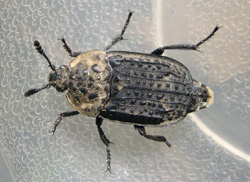Well, the swallow nesting season is over for another year, and the Violet-green Swallows that for several years have used my nestbox equipped with a camera did not return this year. So, I have again turned the camera on the thistle seed feeder in my backyard. As we move into Fall and Winter, I expect the usual visitors to show up again: American and Lesser Goldfinches, House Finches, and occasional Black-capped Chickadees and Red-breasted Nuthatches. Last year a Dark-eyed Junco also figured out how to use it. Some images and descriptions of swallow-related events during recent years are recorded below. Maybe next year the swallows will be back. My email address is fschrock[at]gmail.com if you should care to comment.
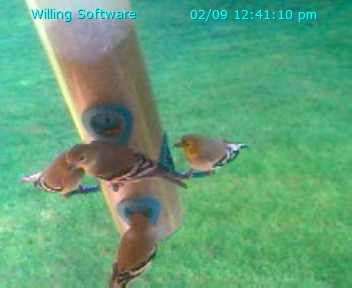
Location: City of McMinnville in Yamhill County, Oregon, USA
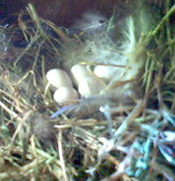
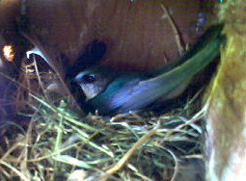
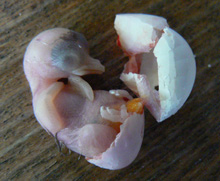
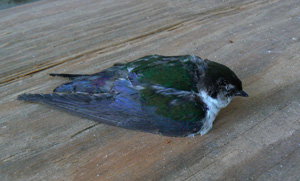
The eggs were laid during the first few days of June. The female immediately began to incubate them, but I did wonder why she spent so much time away from the nest on rainy, cool days. I worried then about the eggs getting too cold, but I guess I worried about the wrong thing. A few days after the female died, the opened egg revealed a well-developed chick that probably would have hatched soon.
Back on May 29 (just before egg-laying started) the female carried in a beetle and released it alive inside the box. I caught the beetle when I saw it heading for the exit, and took some photos of it. One of the photos, and more about that phenomenon which has occurred in each of the past three seasons, is recorded below.
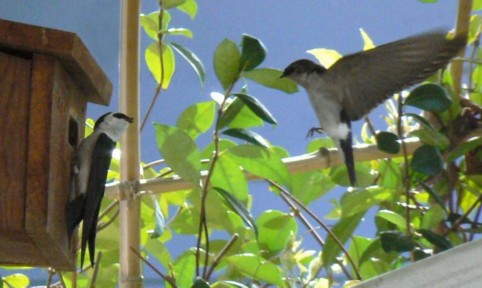
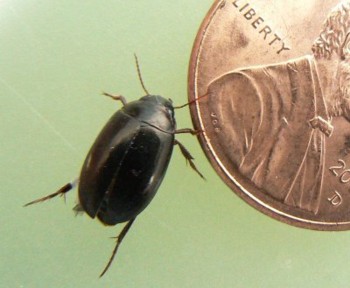
Comments and questions welcome at fschrock1[at]yahoo.com
I also post occasional photos of birds and other creatures I encounter along the way. They can be seen at:
On June 30 the adult female swallow vigorously and repeatedly attacked the three surviving nestlings throughout the day. (Two had earlier been ejected from the nest during the extremely hot weather.) By the end of the day one of the three was dead and had also been ejected by the female. The other two stirred only occasionally for about 6 hours, and when they began to revive and make some noise, the female came in and resumed her attack. By noon the next day (July 1) they also had died. I captured many images of these events, but I've chosen not to display them because of their disturbing nature. I assume that there is a scientific explanation for what happened, but so far it is a mystery. Some have suggested that the true mother of the nestlings had for some reason disappeared, and the female who did the damage wanted to replace the young birds with her own offspring. I wish I could say I had seen anything to support that idea, but this female appeared to be very much at home in and around the nestbox. After all, she had ejected the first two, but then appeared to continue her normal care for the remaining three -- until June 30.
I have placed some images at the following link that I recorded during the female's violent attacks. They might be disturbing to some viewers, so please consider carefully before clicking here.
Back on April 9 we could not have imagined such a thing happening. On that day the female Violet-green Swallow entered the nestbox for her first inspection after returning from wherever she spent the winter. By the end of May, she had brought in quite a lot of grass and feathers, and on June 4, I found two eggs in the nest. By noon on the 7th there were five, and the next time I checked on June 10 there were six. At 7:00 a.m. on June 22 there were broken egg shells outside the nest cup and at least one visible young bird. At 10:30 three heads were reaching up to be fed, but at least one egg had still not hatched. To see several images captured at different stages of nest-building, please scroll down.
These images were captured by the nestbox camera between April 9 and May 25, 2006.
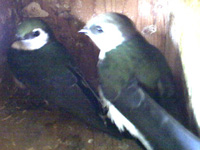
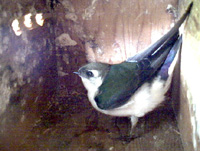
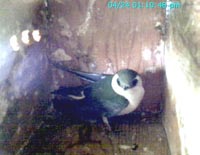
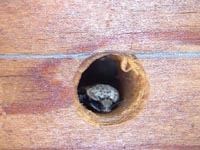
(On April 23 I saw the female bring in a live insect and release it. After she left, the insect, which I believe was a beetle of some kind, crawled around briefly, and soon found its way to an opening. I was able to take a photo of the head end of it. The following day, the same behavior was observed again. So far I have not heard or read of any certain explanation for this, but several observers have suggested that she might be bringing in beetles that will kill potential insect parasites.)
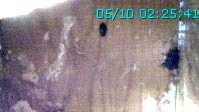
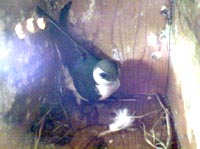
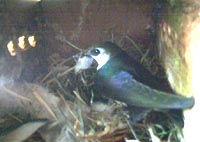
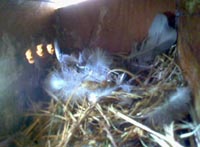
(On May 29 I noticed that there were again several large beetles in the nestbox, and the female swallow on at least two occasions picked one up and set it down in another spot. It seems clear that she had intentionally brought them into the box. After they had spent some time crawling around in the grass of the nest, they then headed for openings to the outside. I quickly went out to the box and captured three of the beetles as they crawled out, and identified them all as Northern Carrion Beetles [Silpha lapponica] which are said to feed on fly maggots. Perhaps that is the reason for their live capture and delivery to the nest. Below is a photo of one of the 1/2 inch beetles.)
